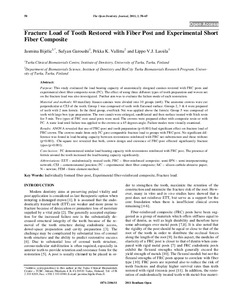Fracture load of tooth restored with fiber post and experimental short fiber composite
Bijelic Jasmina; Garoushi Sufyan; Vallittu Pekka K; Lassila Lippo V J
https://urn.fi/URN:NBN:fi-fe2021042715235
Tiivistelmä
PURPOSE:
This study evaluated the load bearing capacity of anatomically designed canines restored with FRC posts and experimental short fiber composite resin (FC). The effect of using three different types of tooth preparation and woven net on the fracture load was also investigated. Further aim was to evaluate the failure mode of each restoration.
MATERIAL AND METHODS:
80 maxillary frasaco-canines were divided into 10 groups (n=8). The anatomic crowns were cut perpendicular at CEJ of the tooth. Group 1 was composed of teeth with flattened surface. Groups 2, 3 & 4 were prepared of teeth with 2 mm ferrule. In the third group, everStick Net was applied above the ferrule. Group 5 was composed of teeth with large box type preparation. The root canals were enlarged, sandblasted and then surface treated with Stick resin for 5 min. Two types of FRC root canal posts were used. The crowns were prepared either with composite resin or with FC. A static load until failure was applied to the crowns at a 45 degrees angle. Failure modes were visually examined.
RESULTS:
ANOVA revealed that use of FRC-post and tooth preparation (p<0.001) had significant effect on fracture load of FRC-crown. The crowns made from only FC gave comparable fracture load to groups with FRC-post. No significant difference was found in load-bearing capacity between restorations reinforced with FRC net-substructure and those without (p>0.001). Chi-square test revealed that both, crown design and existence of FRC-post effected significantly fracture types (p<0.001).
CONCLUSION:
FC demonstrated similar load bearing capacity with restorations reinforced with FRC post. The presence of ferrule around the tooth increased the load bearing capacity significantly.
ABBREVIATIONS:
EET - endodontically treated teeth; FRC - fiber-reinforced composite; semi-IPN - semi-interpenetrating network; CEJ - cementoenamel junction; FC - experimental short fiber composite; SiC - silicon carbide abrasive paper; N - newton; FEM - finite element method.
KEYWORDS:
Experimental fiber-reinforced composite; Fracture load.; Individually formed fiber-post
Kokoelmat
- Rinnakkaistallenteet [27094]
